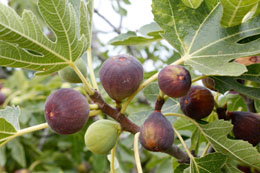Though it is one of the easiest fruits to grow, many people wonder when and how to prune fig trees. This article gives some basic guidelines on how to grow, care for, and prune a fig tree.

A fig tree is a large, deciduous tree that belongs to the species
Ficus carica, and is native to southwest Asia and the Mediterranean regions of the world. It is a picturesque deciduous tree with a smooth, gray bark that grows to a height of 20-30 feet. The tree has muscular, multiple twisting branches and large, single, bright green foliage. The tree grows tiny flowers, usually clustered inside its green fruit. It has green edible fruits which turn purple or brown on ripening, they have a white inner rind containing a seed mass bound with jelly-like flesh.
Growing
The tree grows well in well-drained and fertile soil with a high organic content. For an optimum yield, the soil should have a pH between 6.0 to 6.5. Also, the soil should be well-moistened but ensure that excess nitrogen is not present in it. The tree requires sufficient water; hence, mulch the surrounding soil to preserve moisture, otherwise its foliage may turn yellow and droop. If you are growing many fig trees, plant the cuttings at least 15 to 20 feet apart. Ensure that the plants get full sunlight and sufficient space for growth. For proper maintenance and care, fertilize the trees annually; but, if you have a dense soil, fertilize when the bud swells. In borderline climates, if grown outdoors, make sure that the tree gets proper protection from frost, otherwise its roots may get damaged. The tree can be harvested as soon as the fruits become soft and start ripening.
Pruning
Pruning can be a bit tricky. The first time you need to prune the tree is while transplanting the young fig plant; just trim the tree back by half so that its roots and side branches can develop well in order to grow a bruiser tree. In the next winter, you can prune the tree by keeping a few selective branches and cutting away the rest for a healthy yield. After the tree is well-established, the best time to prune is in the winter when it is dormant and the tree is not growing. Remove the branches that are not growing, especially the ones that have dead or diseased wood. Also shed away the secondary branches, i.e. branches that are growing off the main branches and will not produce the healthy fruit. Finally, prune the main branches by ⅓ or ¼ so that the tree directs its energy in producing sweeter and larger fruits for the next season.
Pruning benefits the tree by improving the fruit yield. For the best results, avoid pruning during heavy winter, as this may cause loss of the following year's crop. Hence, it is better to prune immediately after the main crop is harvested.






 A fig tree is a large, deciduous tree that belongs to the species Ficus carica, and is native to southwest Asia and the Mediterranean regions of the world. It is a picturesque deciduous tree with a smooth, gray bark that grows to a height of 20-30 feet. The tree has muscular, multiple twisting branches and large, single, bright green foliage. The tree grows tiny flowers, usually clustered inside its green fruit. It has green edible fruits which turn purple or brown on ripening, they have a white inner rind containing a seed mass bound with jelly-like flesh.
A fig tree is a large, deciduous tree that belongs to the species Ficus carica, and is native to southwest Asia and the Mediterranean regions of the world. It is a picturesque deciduous tree with a smooth, gray bark that grows to a height of 20-30 feet. The tree has muscular, multiple twisting branches and large, single, bright green foliage. The tree grows tiny flowers, usually clustered inside its green fruit. It has green edible fruits which turn purple or brown on ripening, they have a white inner rind containing a seed mass bound with jelly-like flesh.